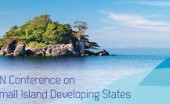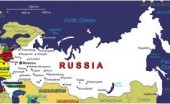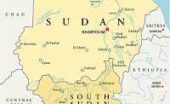Re Ian Bremmer 'Could third-party candidates upend the 2024 US election?' 3 April The current political movement in the USA…
APEC 2014
Written by Diana Thebaud Nicholson // November 15, 2014 // Asia/Pacific // Comments Off on APEC 2014
Behind the APEC Summit’s landmark deals
(Fortune) China’s unexpectedly easy cooperation with the U.S. on climate change, security and trade says a lot about the interests at the very top: Barack Obama’s legacy and Xi Jinping’s ambitions, says Elizabeth Economy, director in Asia Studies at the Council on Foreign Relations.
The outcome of this week’s APEC summit meeting between U.S President Barack Obama and Chinese President Xi Jinping was better — much better — than most observers had anticipated.
The two leaders managed to downplay their differences and celebrate their common interests, striking three bargains and issuing a joint statement of intent. The agreements covered the waterfront —a decision to reduce or eliminate tariffs on information technology products, a plan to extend the term of visas, a promise to develop rules of the road for maritime and air encounters in the western Pacific, and a commitment on the part of both countries to take action to address climate change by reducing their carbon emissions. Whatever acrimony might have emerged over issues, such as Hong Kong or cyber, was kept under wraps in favor of a positive message of expanding the common ground between the two countries.
David Ignatius: Power plays at the APEC summit in Beijing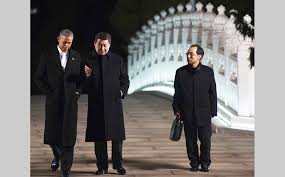
(WaPost) The photograph on Tuesday from Beijing was as carefully arranged as a display of Ming pottery: Presidents Barack Obama and Xi Jinping discussing the world’s business as they walked, side by side, across a bridge with ornate, brilliantly illuminated lampposts.
The artfully staged image conveyed a message: China has arrived as a great power. Its leader stands nearly as tall as the American president (and he’s ready, as he showed later, to speak American-style, without notes, at a news conference). Rather than claiming it is unable to share responsibility, a strong China now seems ready to do business.
The surprise of the Beijing summit was that a weakened Obama, a week after a pulverizing midterm election, was able to gain significant agreements on reducing carbon emissions , lowering tariffs for information technology, sharing intelligence about terrorism and helping the two nations’ militaries avoid miscalculations.
… At a deeper level, the Beijing summit symbolized China’s embrace of its new status as a great power — which is a mixed blessing from the U.S. standpoint. In past encounters, Chinese leaders have often responded to U.S. requests for cooperation by insisting on their weakness: China is still a poor country; its military is tiny compared with that of the United States. U.S. officials have come to see this “humble pie” talk as a way of ducking responsibility; China’s strategy, in their view, was to “hide and bide,” until ready to stand level with the United States.
This moment may have come in Beijing. “China is ready to work with the United States to make efforts in a number of priority areas,” said Xi in his joint news conference with Obama. This appearance was itself a show of confidence (and of intimidation, in Xi’s remarks about journalists).
The APEC summit and the Pacific rim
Bridge over troubled water
This week’s summit in Beijing helped, but great-power rivalry still threatens the Pacific
(The Economist) IN CHINA even a handshake is an expression of power. When Xi Jinping met Barack Obama in Beijing this week at the Asia-Pacific Economic Co-operation (APEC) summit, Mr Xi stood on the right, his body open towards the cameras in an attitude of confident strength. The visitor was required to approach him, as if paying tribute, from the left, shoulder defensively towards the photographers. These days, from the smallest details of summit choreography to the biggest global issues, the rivalry between China and America trumps everything.
On the face if it, diplomacy triumphed this week. There was an even more momentous handshake—the long-awaited, reluctant one between Mr Xi and Shinzo Abe, the Japanese prime minister, which signalled a lowering of tensions over disputed islands. Mr Xi and the president of the Philippines, Benigno Aquino, had a “meeting of minds” over a separate maritime matter. China and South Korea agreed a trade deal of their own. And America and China made real progress on climate change, visas, trade and security. Compared with the torpor and occasional ill-temper of previous APEC summits, this was visionary stuff (see article), and the summitry is now moving on to Myanmar and Australia. The trouble is that all this is only a first step in diffusing the tensions in the Pacific created by the rise of China and America’s relative decline.
I’m sailing right behind—in a gunboat
Ever since the second world war, America’s naval might has guaranteed Asia’s security. Richard Nixon’s visit to Beijing in 1972 was celebrated because it aligned America and China against Soviet Russia. But it also signalled China’s willingness to help America end the Vietnam war, and thus to tolerate an Asian pax Americana. Those days are now at an end.
China’s economy will soon overtake America’s to become the world’s largest. China is once again in league with Russia—on November 9th the two signed another huge gas deal. In a head-on war China’s armed forces would be no match for America’s. But their growing strength will increasingly keep America at arm’s length, prevent it from protecting Taiwan and pose a threat to its bases in South Korea and Japan. Mr Xi could not have been clearer when he declared, earlier this year, “It is for the people of Asia to…uphold the security of Asia.”
China’s growth is not the only reason for change. As our special report in this issue sets out, the Pacific rim as a whole has become too prosperous and too complex for the ocean to be either America’s lake or China’s. The Asian middle class has increased sevenfold since 2000. In Latin America, by contrast, it has merely doubled. Asian countries, including South Korea, have become influential actors in world trade. America is their chief ally and China their largest trading partner. They do not want to be satellites of either.
Unfortunately, pax Americana is giving way to a balance of power that is seething with rivalry and insecurity.
Everywhere China sees American plots designed to prevent its rise. American alliances contain it, foreign-funded NGOs undermine the Communist Party, and spies foment protests in Hong Kong and among the Uighurs in Xinjiang. In August a Chinese fighter-jet and an American surveillance plane passed within 20 feet, just avoiding a mid-air collision. Perhaps because Mr Xi and Mr Obama understand that this could have plunged the two superpowers into crisis they pledged this week to improve military communications. Smaller countries, for their part, are alarmed by Chinese bullying—especially over disputed claims to rocks, shoals, reefs and sandbanks around China’s coastline. Chinese high-handedness drove Myanmar towards the West and provoked anti-China riots in Vietnam this year. Asia is arming itself. In the five years to 2013 it accounted for 47% of global weapons imports, up from 40% in 2004-08.
America, naturally, wants to maintain the status quo. Mr Obama, who grew up in Hawaii, stressed this week that his is a “thoroughly Pacific nation”. But American diplomacy is at best distracted and at worst divisive. Rhetoric about “pivoting” and “rebalancing” towards Asia was meant to reassure America’s allies; instead it fed Chinese paranoia. China appreciates Western-inspired rules in commerce. But America’s ambivalence over whether China will one day be welcome to join its grand trade deal, the Trans-Pacific Partnership (TPP), has allowed even that to become a source of tension. As China grows, it deserves a bigger role in international institutions, yet Congress has blocked reforms to give China more clout in the IMF.
All this has encouraged China to set up its own clubs—its own trade deal, its own development bank and its own regional-security grouping. The bank may be useful, but this approach will not serve China well. Global institutions such as the world trading and financial systems, freedom of navigation and international action on climate change are vital for the country’s prosperity. China weakens them at its peril.
All your dreams are on their way
Rather than entrench rivalries by creating two parallel systems, the Pacific powers should focus on adapting today’s institutions. Trade could become the exemplar. TPP should be a symbol of America’s commitment to the Pacific; with more effort, Mr Obama could sell it to both a pro-business Republican Congress and a foot-dragging Japan. By making vigorous efforts to get China to join, America could signal that it wants to build an inclusive world order. More than that, TPP could show the nationalists in Beijing that a rules-based international system will benefit China more than great-power jockeying. Asia needs such institutions in almost every sphere.
Nineteenth-century Europe discovered how difficult it is to use the balance of power to keep the peace. For decades it laboured to absorb the rise of Wilhelmine Germany and Imperial Russia, and the decline of Austria-Hungary, before succumbing to war in 1914 in a fit of nationalistic fervour. A lot of blood had to be spilled before the Atlantic countries understood that institutions—NATO, the UN and even the unloved European Union—are needed to shore up international relations. Let us hope that the Pacific, cradle of so many of the world’s hopes, can reach that understanding by peaceful means.
Apec summit: China and Japan in ice-breaker talks
(BBC) The leaders of China and Japan have met for formal talks after more than two years of severe tension over a territorial dispute.
Chinese President Xi Jinping and Japanese PM Shinzo Abe met on the sidelines of the Asia-Pacific Economic Co-operation (Apec) summit in Beijing.
Their first meeting included a public handshake with little sign of warmth.
China-Japan Relations: Abe And Xi APEC Meeting Only Symbolic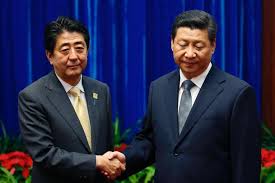
(International Business Times) For the first time in more than two years, China and Japan’s top leaders shared a symbolic handshake at the Asia Pacific Economic Cooperation summit in Beijing earlier this week. The meeting between Japan’s Shinzo Abe and China’s Xi Jinping was described by various news outlets as “uneasy,” “awkward,” but was also considered to be an important “icebreaker” in what are otherwise icy relations between the East Asian nations.
Ahead of the meeting, Japan and China met on Nov. 8 in Beijing to boost bilateral cooperation in hopes of restoring high-level talks. And while that meeting was promising, the brief and awkward sign of a truce already appears to be over.
At the root of contention between the two countries is a cluster of resource-rich islands in the East China Sea which both governments lay claim to. To the Chinese, the islands are known as the Diaoyu, and to the Japanese the Senkaku. Despite the Abe-Xi meeting at the APEC conference, China and Japan are still far from a resolution.
In an report published by China’s state-run Global Times, titled “China slams Japan’s Diaoyu claim,” published on Thursday, Chinese representatives in Tokyo push back on Japan’s unwavering position. In a statement, Japanese foreign minister Fumio Kishida denied that there was a territorial dispute in the East China Sea, calling the islets “Japan-controlled.”

